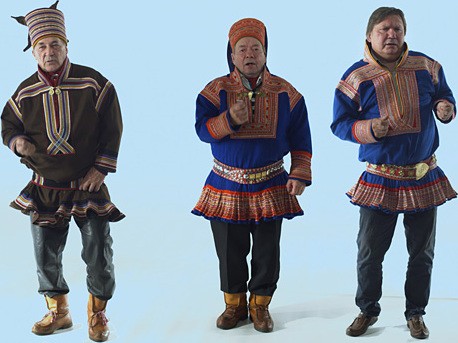
Elle Sofe Henriksen, Juoigangiehta (Jojkarens hand), 2011 © Elle Sofe Henriksen (Norge, 5 min)
Tempo Documentary Film Festival
9.3 2013
Stockholm
Speak Your Mind – Sami Voices!
STOCKHOLM 9 MARCH 2013 AT 13-16.30
The Auditorium, Moderna Museet
Tempo Film Documentary Festival 5–10 March 2013. Tickets
Programme 1, 1-2 PM
Emil Trier – I Came Here
Norway, 2011, 5 min
I CAME HERE is a hybrid between a music video and a short documentary. The film is part of a trilogy about contemporary, Norwegian youth culture, and is a collaboration between director Emil Trier and the musician Torgny. This is a portrait of Sami youth, shot on location in Kautokeino in Northern Norway.
Anne Merete Gaup – EAHPÁRAš
Norway, 2011, 7 min
The shortfilm ”EAHPÁRAš” is about a true phenomenom in Sàpmi. EAHPÁRAš is a dangerous spirit of a dead newborn child and it haunts people. An EAHPÁRAš urges to be baptized and given a name.
Liselotte Wajstedt – Rockabilly
Sweden, 2006, 8:33 min
Reindeers dance on a snowy field in Nothern Sweden, in December, with 25 degrees below zero, on the day that the tsunami hits Thailand. This was the director’s first encounter with reindeers, and the film is a result of her feelings about the meeting
Nils John Porsanger – Reindeer Princess
Norway, 2009, 28 min
Anne Risten is a Sami girl from Norwegian Lapland. She participates in reindeer races together with her reindeer Ena. She uses to win in this man-dominated sport. Neither misfortunes nor injuries slow down her triumphal march.
Gjert Rognli – The Forgotten Place
Norway, 2009, 10 min
In the spiritual landscape moves wanderer between life and death, the tender and pure meet the vibrant life of pain. A fight between the inner and outer landscape of the human mind. In a world colored by our time and fate.
Programme 2, 2.15–3.30 PM
Liselotte Wajstedt – Faces
Sweden, 2008, 3:29 min
It is Samis whose faces are like landscapes, faces integrated in the landscape so that they are a part of a bigger entity. Music is made by Peter Svenzon and it is made only with voices, without instruments. The film is included in a dance performance ”Sami”, by Charlotte Öfverholm.
Elle Sofe Henriksen – The Yoiking hand
Norway, 2011, 5 min
”Juoigangiehta”, the yoiking hand is a dance film featuring the unrehearsed and natural movements of 3 traditional sámi yoikers (singers).
Elle Sofe Henriksen and Ken Are Bongo – The Wind Whispers There is Someone Behind the Tundra
Norway, 2006, 10 min
The choreography is an abstract description of evolution, inspired by Synnøve Persen´s poem. The dancers travel through time and space, on rough land enjoying the wonders of the sky. During their journey they come cross objects related to the development of the Sámi people. The poem reveals a belief in the powers of nature inspired by and linked to the Sámi ancestors. The poem is abstract but is open for broader interpretation.
Richard Fagervoll, Maret Aile Sara and Kristine Heitmann – Alone
Norway, 2010, 15 min
”Okto – Alene” is a film about 18 years old Lemet Ande. Lemet from Karasjok in Norway ia a homosexual. All his life he has been bullied because he is different than others. Some days was so hard so he was thinking of suicide. The film is dealing with a life in dubble minority both as a sami and as a homosexual.
Kirsti Länsman – Legacy
Finland, 2007, 5 min
Grandmother is transferring the traditional knowledge and skills to the next generation, to her grandchildren.
Christian Bermudez – Drive-thru
Norway, 2011, 20 min
Every summer more than 200.000 tourists visit North Cape, Norway. This is the northernmost point in Europe. A few kilometers before reaching their goal, a 10-15 minute stop is their only chance to encounter Sámis (Lapps) the indigenous people of Northern Europe, and set foot on Lappland and experience the tundra landscape.
‘Drive-Thru’ observes the tourist as they visit Nils’ summer camp. Nils is a reindeer herding Sami who has worked with reindeer husbandry for generations. Every year, Nils and his wife Anna migrate with their herds between coast and inland areas as part of traditional nomadic herding, according to reindeer annual migration route.
Nils’ picture can be found on thousands of photo albums around the whole world. He assures that once he retires he will travel the world taking pictures of every local he’ll meet. In any case, ‘Drive-Thru’ is less about Nils and more about being observed and looking to the observers; while at the same time it is a humor-filled anthropological study to contemporary tourist industry and traveling in XXI century.
After the films follows a talk with curator Anna Linder
The shortfilm programmes are shown in collaboration with The Sami Week in Umeå.
Curator: Anna Linder
Programme 3
LISELOTTE WAJSTEDT – Kiruna – Ryndvägen
Sverige, 2013, 52 min.
The city of Kiruna is about to move. Whole blocks are beeing demolished, houses are moving and a new part of the city will be constructed.
Liselotte Wajstedt grew up in the surroundings of the Company, and is scrutinizing both dark and good memories of her background among the beloved concrete walls, before everything is gone. How do we remember what we have forgotten?
